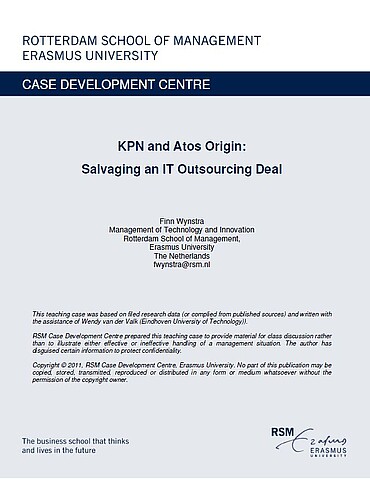Citation Note
Based on published sources; 10 pages.
Follow the 'handle' link to access the Case Study on RePub.
For EUR staff members: the Teaching Note is available on request, you can contact us at rsm.nl/cdc/contact/
For external users: follow the link to purchase the Case Study and the Teaching Note.
Objective
As a typical, traditional telecommunications sector incumbent, KPN has developed into a complex, vertically integrated organisation. Faced with increasing competition and deregulation alongside increasing financial problems, KPN is considering major outsourcing initiatives. The case dilemma concentrates on the question of whether and how to revitalise an outsourcing relationship that has not delivered the expected results. Other options include finding another supplier, taking on an additional supplier(s), or going back to insourcing. Specific to the discussion on how to revitalise the current outsourcing relationship is the definition and alignment of Key Performance Indicators, in a situation where both the supplier and the client have a substantial impact on the service delivered by the supplier. In addition, the question is how to keep these KPIs manageable and how to tie them to (financial) incentives. When considering whether or not to involve additional supplier(s), the discussion involves the trade-offs between the advantages/disadvantages of single sourcing and the advantages/disadvantages of multiple sourcing. This discussion should be linked to an analysis of the type of activities specified in the case (datacenter), and the context of the outsourcing decision: a company with relatively little outsourcing experience that needs to achieve results reasonably quickly. In the discussion on whether or not to return to in-sourcing the datacenter activities (and possibly also the other IT activities), it is also important to consider the specific nature of these activities. Are they really ‘critical competencies’ for the organisation given the current market context?
description
KPN developed from a traditional telecommunications sector incumbent into a complex, vertically integrated organization. Faced with increasing competition and deregulation alongside increasing financial problems, KPN considered revitalizing an outsourcing relationship that had not delivered expected results.
Abstract
In late 2003, Willem van Oppen, Chief Procurement Officer of KPN, the incumbent telecommunications service provider in the Netherlands, had to confront an outsourcing project gone sour. Two years prior, in one of the first major outsourcing deals at KPN, a substantial part of its IT services were outsourced to Atos Origin. However, KPN felt it was facing a supplier that had not demonstrated the value-adding capabilities which KPN strongly emphasized throughout the outsourcing decision process. Atos Origin was experiencing continuous problems in the daily operation of KPN’s IT support processes and seemed reluctant to make any fundamental improvements. Some managers were pushing the newly established procurement organization and, in particular, the IT category managers to get a better grip on the outsourcing deal, and some were even challenging the outsourcing decision itself.
usage
The case can be used in courses on Operations Management, Supply Chain Management, and Strategic Sourcing, but also in more specialised courses such as Outsourcing, Service Procurement, Business-to-Business Marketing/Relations, or IT Strategy. The case is as useful with MBA/EMBA students as with MSc students with less working experience. Typically, in MBA/EMBA groups, it is easier and more effective to go into depth regarding the outsourcing process and the challenges of contracting. Experience shows that participants do not need to have a background in IT and/or (out)sourcing to create a meaningful and lively classroom discussion, as the topic and the case itself are recognizable for most managers and executives. In groups of students with less working experience, the discussions on the outsourcing decision per se and the choice between single versus multiple sourcing are typically the most engaging.
